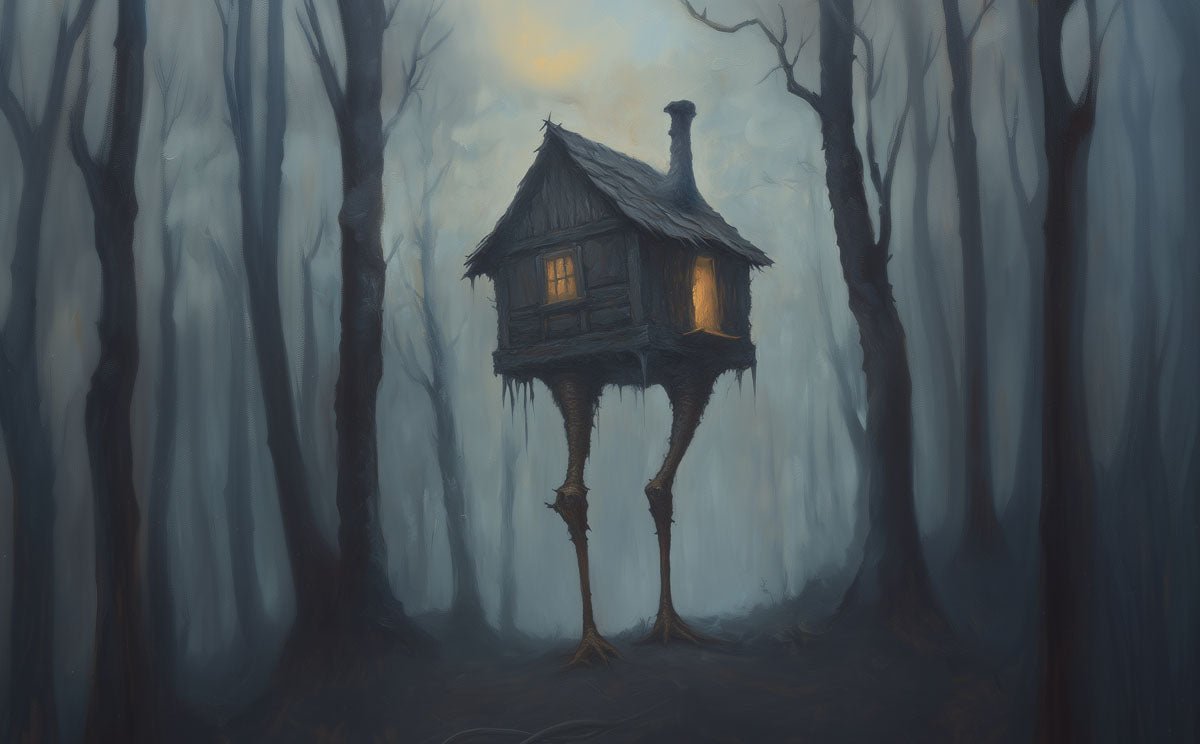Baba Yaga: The Enigmatic Witch of Slavic Folklore
Hiding deep within the ancient, enchanted forests of Slavic folklore is Baba Yaga, a figure both feared and revered. Often depicted as a crooked, old witch with a nose that curves like a claw and flying through the woods in a mortar, Baba Yaga is far more than a mere villain of fairy tales. She is a complex symbol of power, transformation, and the untamable forces of nature.
Whether you're a witchcraft practitioner drawing inspiration from her wisdom, a folklore enthusiast captivated by tales of her mystique, or someone keen to connect with Slavic heritage, Baba Yaga's legend has something for everyone to explore.

Who Is Baba Yaga?
Baba Yaga is one of the most iconic figures in Slavic folklore. She resides in a magical, spinning hut balanced on chicken legs, located in the heart of a dark forest. Her home is surrounded by a fence made of human bones, an ominous warning to those who might approach uninvited.
Though commonly described as an old, grotesque crone with sharp teeth and iron legs, Baba Yaga is not a one-dimensional figure. She serves as both a force of fear and fascination, a witch who can bring both aid and doom. This duality makes her unique in the world of folklore, embodying ambiguity and timeless allure.
Name Origins
The name "Baba Yaga" reflects her nature and cultural heritage. "Baba" is a term that can mean "grandmother" or "old woman" in many Slavic languages. "Yaga" has more elusive origins but is often interpreted to mean "horror," "anger," or "disease," suggesting her connection to danger and supernatural power.
Lessons from the Legend
Baba Yaga’s stories often challenge moral and cultural norms. She tempts the brave and punishes the foolish, but for those clever enough to win her favor, she can be an invaluable ally.
The Moral of the Story
In many Slavic fairytales, Baba Yaga serves as a test for the protagonist. She often gives impossible tasks, like spinning magical threads or capturing fireflies. Success in these tests depends on the hero or heroine's wit, resourcefulness, and sometimes a little help from magical friends.
These tales teach us something deeper. Baba Yaga reminds us of the importance of respecting nature and its cycles. She represents growth through adversity, illustrating how challenges can ultimately lead to transformation and self-discovery.
Witchy Symbolism
For witchcraft practitioners, Baba Yaga embodies the chaos and wisdom of the Crone archetype. She is a wild, untamed witch connected to liminal spaces and the cycles of life, death, and rebirth. Her home, the chicken-legged hut, spins endlessly between worlds, representing the boundary between the earthly and the ethereal. Baba Yaga challenges us to confront the unknown and rely on our inner strength to persevere.
She is also often linked with herbal magic, healing, and the secrets of the natural world. Practitioners who work with plant magic, divination, or shadow work may feel drawn to her energy.
Baba Yaga in Slavic Culture
Baba Yaga is not just a witch; she is a personification of Slavic cultural roots. For centuries, she has been a symbol of mystery, danger, and feminine power within Slavic traditions. Her stories passed through generations, hold historic wisdom about harmony with nature, community survival, and the consequences of hubris.
Her spinning hut, her mortar and pestle, and the bone-fence around her home are not just eerie details; they are deeply symbolic. The hut represents constant movement and transition, the mortar symbolizes grinding and transformation, and the bone-fence is a stark reminder of the infinite cycle of life and death.
Why Is Baba Yaga Relevant Today?
Baba Yaga’s enduring mystique continues to captivate modern audiences. From her appearances in literature, such as in the works of Russian poet Aleksandr Pushkin, to portrayals in movies, video games, and even Tarot decks, Baba Yaga persists as a figure for cultural inquiry and inspiration.
For those passionate about eco-feminism, Baba Yaga is a potent symbol of the wild woman archetype. She embodies women's strength, wisdom deeply connected to the land, and the untamed forces that resist control.
Meanwhile, for witches, she represents the archetype of the Crone as a sacred teacher, reminding us of the power found in shadows, transformation, and the cyclical nature of life.
Invoking Baba Yaga in Your Practice
If you feel drawn to work with Baba Yaga in your witchcraft practice, approach with respect and care. Here are a few ways to honor her:
- Create an Altar: Dedicate a space for her with symbols like bones, herbs, candles, and depictions of her spinning hut. Consider including items linked to nature, like leaves or feathers, to connect with her wild energy.
- Work with Herbs: Baba Yaga is said to have extensive knowledge of herbs and their uses. Study local plants, focus on their healing properties, and incorporate them into your practice.
- Shadow Work: Baba Yaga’s challenges often direct us to face our darkest fears. Begin shadow work by journaling, meditating, or consulting Tarot and Oracle decks to uncover your hidden truths.
- Seek Liminal Spaces: Honor Baba Yaga by connecting with nature’s in-between places, such as forests at dusk or secluded crossroads. Spend time there to feel her energy and practice introspection.
Final Thoughts
Baba Yaga is an extraordinary figure who embodies mystery, wisdom, and transformation. Her stories challenge us to think critically, grow courageously, and stay connected to the untamed forces of the natural world. Whether you’re drawn to her lore for its cultural richness, folkloric complexity, or relevance to your spiritual practice, Baba Yaga is a wellspring of inspiration.
What lessons will you take from her stories? Share your thoughts below, and if you’ve encountered her energy in your own practice, we’d love to hear how she’s shaped your path.
Until next time, may the wisdom of Baba Yaga guide your way through the shadows. 🌙





